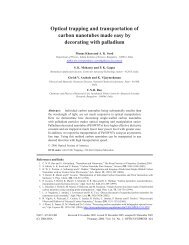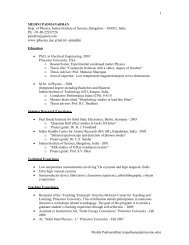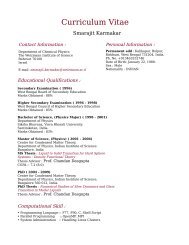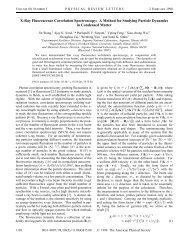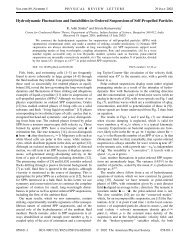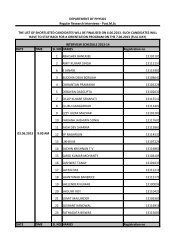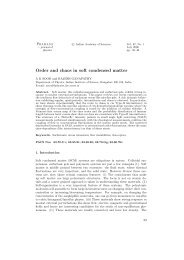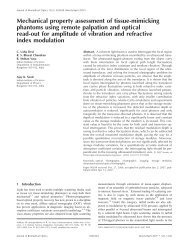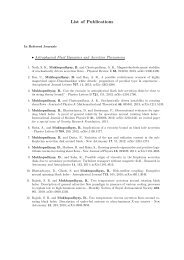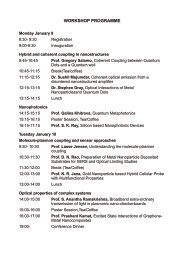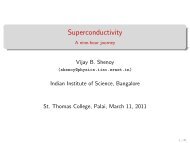Thermoelectric Properties of Fe0.2Co3.8Sb12-xTex ... - Physics
Thermoelectric Properties of Fe0.2Co3.8Sb12-xTex ... - Physics
Thermoelectric Properties of Fe0.2Co3.8Sb12-xTex ... - Physics
Create successful ePaper yourself
Turn your PDF publications into a flip-book with our unique Google optimized e-Paper software.
Molecular dynamics simulation <strong>of</strong> electroporation <strong>of</strong> lipid bilayer membrane<br />
Amit Kumar Majhi, V. Venkataraman, Prabal K Maiti<br />
Department <strong>of</strong> <strong>Physics</strong>, Indian Institute <strong>of</strong> Science Bangalore, India, 560012.<br />
Abstract<br />
MD Simulation [1] has been performed using NAMD and VMD [2-4] to determine the pore<br />
formation time scale for different applied fields and analyzed the movement <strong>of</strong> ions across the<br />
electroporated lipid bilayer membrane. In addition, we have also studied the closing dynamics <strong>of</strong><br />
a pore when the field is switched <strong>of</strong>f. The MD simulation has been performed for a total <strong>of</strong> 100<br />
ns in presence <strong>of</strong> KCl solution <strong>of</strong> 0.2 M concentration in the water layer with different electric<br />
fields ranging from 0.2 V/nm to 1 V/nm to elucidate the pore formation mechanism. The field is<br />
always applied along the z-axis (perpendicular to the lipid layer) after 4 ns <strong>of</strong> equilibration. We<br />
find that a pore formation starts at different time depending on the strength <strong>of</strong> applied fields. For<br />
example, the pore formation starts 1ns after the application <strong>of</strong> an electric field <strong>of</strong> 0.4 V/nm but<br />
for a field <strong>of</strong> 1V/nm pore formation starts after 0.2ns. Once a pore appears on the membrane it<br />
expands quickly but if the field is switched <strong>of</strong>f the pore reseals back but at slower speed. We<br />
have also calculated ionic current as a function <strong>of</strong> time for different applied fields. When the<br />
field is just turned on, the current does not flow at all but after some time it increases sharply.<br />
This sharp rise coincides with the formation <strong>of</strong> the pore. The magnitude <strong>of</strong> the ionic current<br />
through the membrane is found to be 10-20 nA. Pore formation mainly depends on the<br />
magnitude <strong>of</strong> the field which indicates the increase in conductivity <strong>of</strong> the membrane with<br />
application <strong>of</strong> electric field.<br />
References:<br />
1. Low voltage irreversible electroporation induced apoptosis in HeLa cells,. Wei Zhou, Zhengai<br />
Xiong, Ying Liu, Chenguo Yao, Chengxiang Li,. 2012, DOI:10.4103/0973-1482.95179.<br />
2. Scalable molecular dynamics with NAMD. J. C. Phillips, R. Braun, W. Wang, J. Gumbart, E.<br />
Tajkhorshid, E. Villa, C. Chipot, R. D. Skeel, L. Kale and K. Schulten,. 2005, Journal <strong>of</strong><br />
Computational Chemistry, Vol. 26, pp. 1781-1802.<br />
3. VMD: Visual molecular. W. Humphrey, A. Dalke and K. Schulten,. 1996, Journal <strong>of</strong><br />
molecular graphics,. Vol. 14, pp. 33-38.<br />
4. Particle mesh Ewald: An N. log (N) method for Ewald sums in large systems. Darden T, York<br />
D, Pedersen L,. 1993, the Journal <strong>of</strong> Chemical <strong>Physics</strong>, Vol. 98, pp. 10089-10092.



